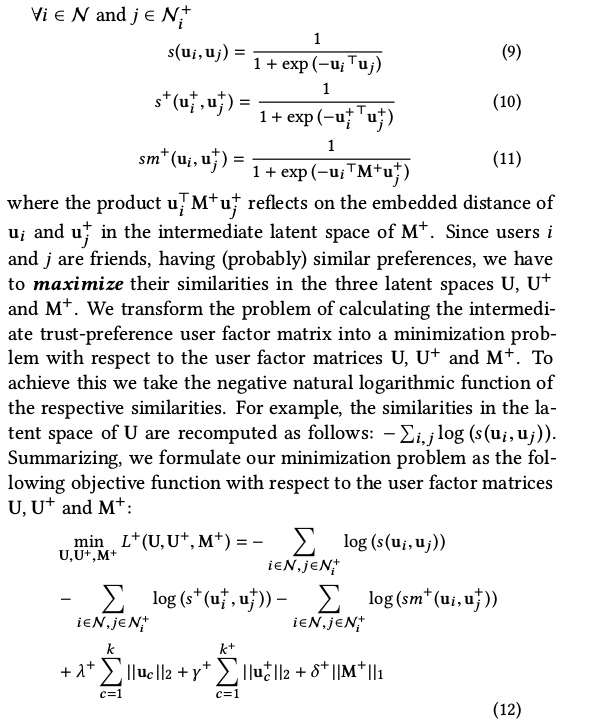本文在用户的协同偏好矩阵的基础上,增加一个用户之间的信任关系,也就是用户信任谁不信任谁这样的一个信息。
本文认为:应该把用户自己偏好的以及用户信任的的朋友(friends)的偏好的item排在前面;而用户不信任的人(foes)所偏好的item排在比较靠后的位置。
所以作者把两个物品“计算出的伪评分”的差做了一个重新定义,在原来之间相减的基础上增加了一些项来表示以上两条的信息如下:

其中,下标i,j,v表示用户,r为评分函数,x_i和y_i分别表示relevant item和irrelevant item,大写Xi表示relevant items集合, N+表示friends下标集合,N-表示foes下标集合,W是用户与用户之间的权重,以下会单独说明。
需要说明的是,相比传统方法,EQ2 中增加的两项并不总是起作用,文章认为,当他们的的和小于0时,就去掉这两项。
然后其objective function是利用了hinge loss function如下:

以下说明权值W的求法:
假设用户有三个隐向量矩阵,U,U+,U-,以及两个媒介矩阵(intermediate)M+和M-。W+=Ux(M+)x(U+), 以至于在求W+时,用户有三个向量空间,U,U+和M+,然后作者假设friend之间这些空间内的距离越近越好;所以有了一个新的objective function如下:

W-的求法思想与求W+ 的思想基本一样,就是要把距离越小越好变成距离越大越好。
| 文献题目 | 去谷歌学术搜索 | ||||||||||
| Learning to Rank with Trust and Distrust in Recommender Systems | |||||||||||
| 文献作者 | Dimitrios Rafailidis | ||||||||||
| 文献发表年限 | 2017 | ||||||||||
| 文献关键字 | |||||||||||
| Learning to rank; social relationships; collaborative filtering; trust-based | |||||||||||
| 摘要描述 | |||||||||||
| The sparsity of users’ preferences can significantly degrade the quality of recommendations in the collaborative filtering strategy. To account for the fact that the selections of social friends and foes may improve the recommendation accuracy, we propose a learning to rank model that exploits users’ trust and distrust relationships. Our learning to rank model focusses on the performance at the top of the list, with the recommended items that end- users will actually see. In our model, we try to push the relevant items of users and their friends at the top of the list, while ranking low those of their foes. Furthermore, we propose a weighting strategy to capture the correlations of users’ preferences with friends’ trust and foes’ distrust degrees in two intermediate trust- and distrust-preference user latent spaces, respectively. Our experiments on the Epinions dataset show that the proposed learning to rank model significantly outperforms other state-of-the-art meth- ods in the presence of sparsity in users’ preferences and when a part of trust and distrust relationships is not available. Furthermore, we demonstrate the crucial role of our weighting strategy in our model, to balance well the influences of friends and foes on users’ preferences. | |||||||||||